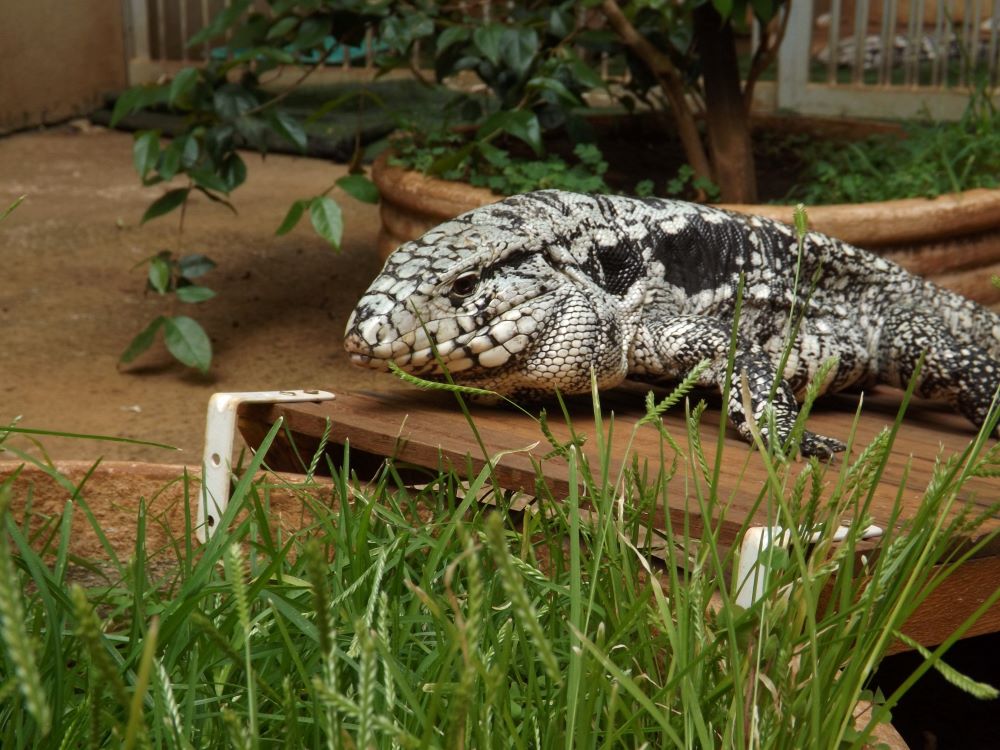


In 2016, researchers supported by FAPESP had shown that tegu lizards reach higher temperatures than the burrows they inhabit in spring. This new study has found a physiological explanation for the phenomenon (photo: Livia Saccani Hervas)
Published on 08/05/2024
By André Julião | Agência FAPESP – A group of scientists supported by FAPESP has revealed the mechanism whereby Salvator merianae – the Black and white tegu, also called the Argentine giant tegu – is able to keep warm by raising its own body temperature during the reproductive season even while it is in a dark burrow. This had never been observed before in reptiles. An article on the study is published in Acta Physiologica, which is owned by the Scandinavian Physiological Society.
“Generally speaking, only birds and mammals are considered endotherms, which can keep warm even in a cooling environment. Reptiles and other animals are considered ectotherms, as they rely on external sources to regulate their body temperature,” said Livia Saccani Hervas, first author of the article. The study began during her scientific initiation at São Paulo State University’s School of Agrarian and Veterinary Sciences (FCAV-UNESP) in Jaboticabal, Brazil.
In 2016, another group of scientists supported by FAPESP discovered that S. merianae’s body temperature remains several degrees above the nocturnal burrow temperature during the mating season (read more at: agencia.fapesp.br/22723).
The species was now known to be part-endothermic, but the origin of this internal heat remained a mystery. Hervas and her group, led by Kênia Cardoso Bícego, a professor at FCAV-UNESP, began investigating the mechanism. Bícego is principal investigator for the FAPESP-funded Thematic Project “Physiological capacities and resilience facing climate change: exploring the functional dimension in ectothermic vertebrates”.
For three years, the group collected biopsies from the skeletal muscles of ten lizards during summer (February) and spring (September-October). Small tissue samples taken from a front foot and back foot were submitted to biochemical analysis and calorimetry.
“We had to take a long time to establish the protocols, especially reagent doses, because this kind of analysis had never been performed on these lizards,” Bícego said.
The researchers found that during the reproductive season the muscles of both males and females produced far more mitochondria (cellular energy organelles).
In addition, a protein present in mitochondria called ANT, known to be involved in a biochemical process that generates heat in birds, was more abundant and more active in the lizards during the reproductive season, when females prepare for egg laying and nest building while males seek territory and increase their gonads to get ready for mating.
UCP, another protein involved in the process of heat generation, but in mammals, was not found to be active during the experiments with S. merianae. Muscle samples collected during the reproductive season produced more heat than in summer owing to the activity of ANT but not UCP.
No shivering
Until the 2016 discovery, the only reptiles known to be able to warm themselves were two species of python, large Asian snakes that can reach 5 m in length. This endothermic behavior occurs mainly while they are incubating eggs. It consists of shivering, a technique also used by some mammals and birds. S. merianae raises its own temperature without shivering, however.
Temperature regulation may be associated with the production of sex hormones, which peaks in the mating season for both males (testosterone) and females (estradiol and progesterone). Other hormones that are abundant in this phase, such as thyroid hormones, are involved in energy expenditure and mobilization of energy reserves.
“Thyroid hormones are known to trigger a rise in mitochondria. Increased production of these hormones during the mating season may be associated with abundance of mitochondria and hence increased activity of the protein ANT, which helps produce heat and is known in birds,” said Hervas, currently a PhD candidate at FCAV-UNESP.
The results of the study, as well as the research findings published by other groups, show that mechanisms involved in endothermy may have appeared in vertebrates even earlier than has been estimated. Their presence in a large lizard (without shivering) and a large snake (with shivering), albeit only at a certain time of year, could be a sign that the phenomenon is more common in reptiles than scientists think.
“Both animals have large bodies, in which internally produced heat tends to take longer to dissipate. It’s possible that other large reptiles may also be warmer than the outside temperature at certain times. This is the first description in a lizard, and one that inhabits a subtropical region, of a cellular heat-generating mechanism that closely resembles what happens in birds and mammals,” Bícego said.
Marcos Túlio de Oliveira, penultimate author of the article, is a professor at FCAV-UNESP, also supported by FAPESP, and head of the laboratory where mitochondrial biochemistry experiments were conducted for the study.
The other co-authors included Ane Guadalupe Silva, with a scholarship from FAPESP; and Lara do Amaral Silva and Marina Rincon Sartori, previous awardees of scholarships from FAPESP.
The article “Mitochondrial function in skeletal muscle contributes to reproductive endothermy in tegu lizards (Salvator merianae)” is at: onlinelibrary.wiley.com/doi/10.1111/apha.14162.
Source: https://agencia.fapesp.br/52408